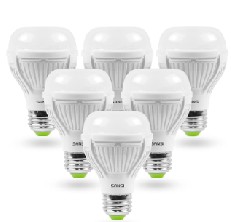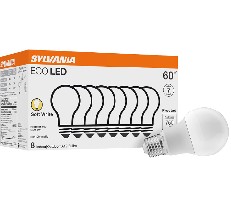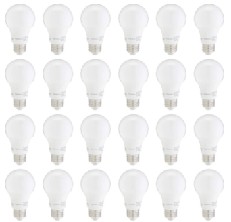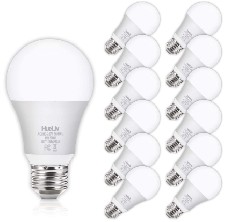This content was originally published on OldHouseOnline.com and has been republished here as part of a merger between our two businesses. All copy is presented here as it originally appeared there.
If you’ve shopped for light bulbs recently, you may have noticed that the variety of LED light bulbs has increased drastically. Incandescent and fluorescent bulbs are present, but due to low demand, their production is decreasing. The biggest reason why LED light bulbs are gaining popularity is that they are very energy efficient.
When compared to fluorescent or incandescent bulbs, which can only provide a life of about five years, LED light bulbs can provide an average life of 20 years. Also, contrary to popular belief, LED light bulbs do not produce harsh light, and you can also choose from a variety of colors and temperatures depending on your preference.
Since there’s such a wide variety of LED light bulbs available in the market, it can be confusing to decide which one to purchase. So, in order to help you out a little, we have broken down the most popular LED light bulbs. Let’s check them out!
LED Light Bulbs: A Buyer’s Guide
What Specifications Should an LED Light Bulb Have?
If you’re new to LED light bulbs and are switching from conventional bulbs like incandescent ones, you’ll notice that the specifications are different for LEDs. Once you know which specifications to look for, making a decision will become much easier.
Lumens
Traditionally, light bulbs were measured in watts, which is a measure of the power or energy that your bulb will consume – no direct brightness measurements were used. But, in LEDs, the brightness is measured in lumens, and this is mentioned on each light bulb.
Since lumens are a relatively new measurement technique, a lot of companies provide their watt equivalent measurements so you can have a better idea of how they’ll compare to traditional bulbs. For example, a 60-watt bulb is equal to a 900-lumen LED light bulb, while a 100-watt bulb will be equivalent to 1,600 lumens.
Color temperature
Color temperature is another important measurement that will give an idea of the type of color your LED light bulb will give off. It is measured in Kelvins, and the lower the temperature, the warmer the light.
Most companies label cool colors as daylight because the human brain perceives cool shades to be close to natural light. For residential applications, the ideal color temperature ranges from 2,000 Kelvins to 6,500 Kelvins. These tones will keep your home cozy while also providing adequate light to work peacefully. You can also choose warmer tones for your living room or bedroom and install cool bulbs in your workplace or study.
Fixture type
The fixture type is an important consideration because it has a direct impact on the life span of an LED light bulb. LEDs can last for decades, but only if they’re able to dissipate the heat that they produce. For this purpose, you need to purchase a bulb that is well-suited to the fixtures you have in your home.
If you have enclosed fixtures, you’ll need to make sure that the LED light bulb you are purchasing is designed for them; such bulbs are not only designed to withstand higher temperatures but can also dissipate heat more efficiently.
Additional features
Some LED light bulbs can come with specialized features, which may not be a requirement but can be beneficial depending on your needs. For example, some LED light bulbs are dimmable, which can be useful as they’ll let you change the light tones depending on the mood and the occasion.
Additionally, some companies are manufacturing bulbs that are equipped with wifi and Bluetooth. This means that you can use voice control to dim the lights or turn them on or off at your convenience. A few LEDs are even equipped with motion sensors, which can serve as a security system because they can alert you if there are trespassers.
Should LED Light Bulbs Be Bought in Bulk?
The quantity of LED light bulbs you purchase will depend on your specific needs. If you want to try them out and decide which type is right for you, only purchase one or two. The important thing to remember is that LED light bulbs used to be very expensive, but their prices have decreased drastically in recent years. When you purchase in bulk, you can save a lot of money because the price of a single bulb reduces even further.
Nowadays, LED light bulbs available in bulk are priced as low as $1 to $2 apiece. So, if these bulbs last for as long as 10 years, they’ll end up being an incredibly good deal in the long run. For commercial purposes, look for value packs that include 50 to 80 bulbs, and for residential purposes, bulbs that come in packs of six to 12 are usually adequate.
Comparing the Highest-Rated LED Light Bulbs
SANSI LED Light Bulb
– Best Overall

The SANSI LED Light Bulbs are highly efficient because they require low power and provide high brightness levels of up to 1,600 lumens. You can choose from packs of one, two, four, and six, depending on your specific requirements, and they come with light transmission optical lenses, which makes them flicker-free. Additionally, the patented ceramic technology reduces thermal resistance, which ensures faster electricity conductivity and improves the reliability of the bulbs.
The average lifetime of these bulbs is about 22 years, and the company provides a five-year warranty. Meanwhile, the efficient insulation structure reduces the risk of electric shocks, and the outside is made from corrosion-resistant materials, making the bulbs more durable. Also, warm and white color options are available, so you can choose one that suits the atmosphere in your home. Due to their durable construction and advanced technology, we picked these LED light bulbs as our top choice.
Pros
- Provides high brightness at low power
- Corrosion-resistant shell
- Hollow design for efficient heat dissipation
Cons
- Lights are not dimmable
SYLVANIA LED Light Bulb
– Most Affordable

If you are looking for an affordable set of LED light bulbs, you should consider this one by SYLVANIA. You can choose from sets of two, four, six, eight, 18, and 24 bulbs that will serve as a great replacement for incandescent bulbs. Also, they have an average life span of about seven years, which means that you won’t need to change your bulbs often. The bulbs are non-dimmable, and you can choose from five color options that range from warm to white light. Best of all, they’re very reasonably priced and are available in a variety of brightnesses, making this pick a perfect choice for any home.
Pros
- Reasonably priced and long-lasting
- Great replacements for incandescent bulbs
- Helps reduce eye strain and fatigue
Cons
- Not very well insulated
Amazon Basics LED Light Bulb
– Value Pack

The Amazon Basics LED Light Bulbs are another one of our favorites because they have a long life and provide instant lighting without any warm-up time. The average life span is about 10,000 hours (or more, depending on the style you buy), which means they’ll last for almost nine years based on the assumption that the bulbs will be used for three hours a day.
Since these LED light bulbs don’t consume too much power, you can save a lot of energy and money if you replace your incandescent bulbs. Even better, you can choose from warm and white colors, depending on your preference and the aesthetic of your room. And if you want to purchase in bulk, these bulbs are a good option because they are available in packs of 24, 32, and 72.
Pros
- High color temperature ensures crisp lighting
- Available in large packs for bulk purchases
- Excellent replacements for traditional bulbs
Cons
- Not ideal for mounting on ceilings
Great Eagle Lighting LED Light Bulb
– Most Compact

The Great Eagle Lighting LED Light Bulbs are one of the most compact options in the market, which allows them to fit in most fixtures easily. When compared to incandescent bulbs, these LED light bulbs can save up to 85% on your energy bill. The average life span is about nine years, so you won’t need to replace your bulbs often. Even better, these bulbs don’t need to heat up like traditional ones and can light up immediately.
Additionally, there are four colors available to choose from, and these light bulbs are also non-dimmable. Meanwhile, their small size makes them versatile, as they can be installed in lamps and are suitable for both home and commercial use. For your peace of mind, the company provides a three-year warranty as well, which means you can purchase from them with confidence.
Pros
- Compact, versatile design
- Available in multiple colors
- Helps save energy
Cons
- Some bulbs may flicker
HueLiv LED Light Bulb
– Best for Eyes

Last but definitely not least, the HueLiv LED Light Bulbs made it to our list due to their efficient design and eco-friendly materials. If your eyes often feel tired due to conventional bulbs, you should consider these bulbs because they’re designed to eliminate eye fatigue and protect your eyesight. Even more, the life span of these bulbs is considerably long, and you can save about 89% energy if you switch to them from traditional bulbs.
Since they are free from toxic materials and do not have any breakable parts, these LED light bulbs are safe for use at home and are also eco-friendly. Further, the 1,100-lumen brightness is ideal for illuminating large areas like living rooms, bedrooms, and even commercial spaces. Most importantly, each pack of four or 12 bulbs is strictly tested before packing to ensure customer satisfaction.
Pros
- Easy to install
- Help eliminate eye fatigue and strain
- Eco-friendly and non-toxic
Cons
- Limited color options are available
People Also Asked
Q: What color of LED light bulbs is safest for the eyes?
A: Warm tones are best if you want to reduce eye fatigue because they do not strain the eyes. This is because it includes filtered light, which reduces exposure to excessive blue light.
Q: Are all LED light bulbs energy efficient?
A: Yes, LED light bulbs are very energy efficient, especially when compared to traditional ones like incandescent and fluorescent bulbs. Even more, these bulbs are eco-friendly as well because they use less energy and have a low carbon footprint.
Q: Can LED light bulbs be left on 24/7?
A: As long as you have purchased high-quality LED light bulbs that can dissipate heat efficiently, you can keep them on 24 hours a day and seven days a week without worrying about overheating.






